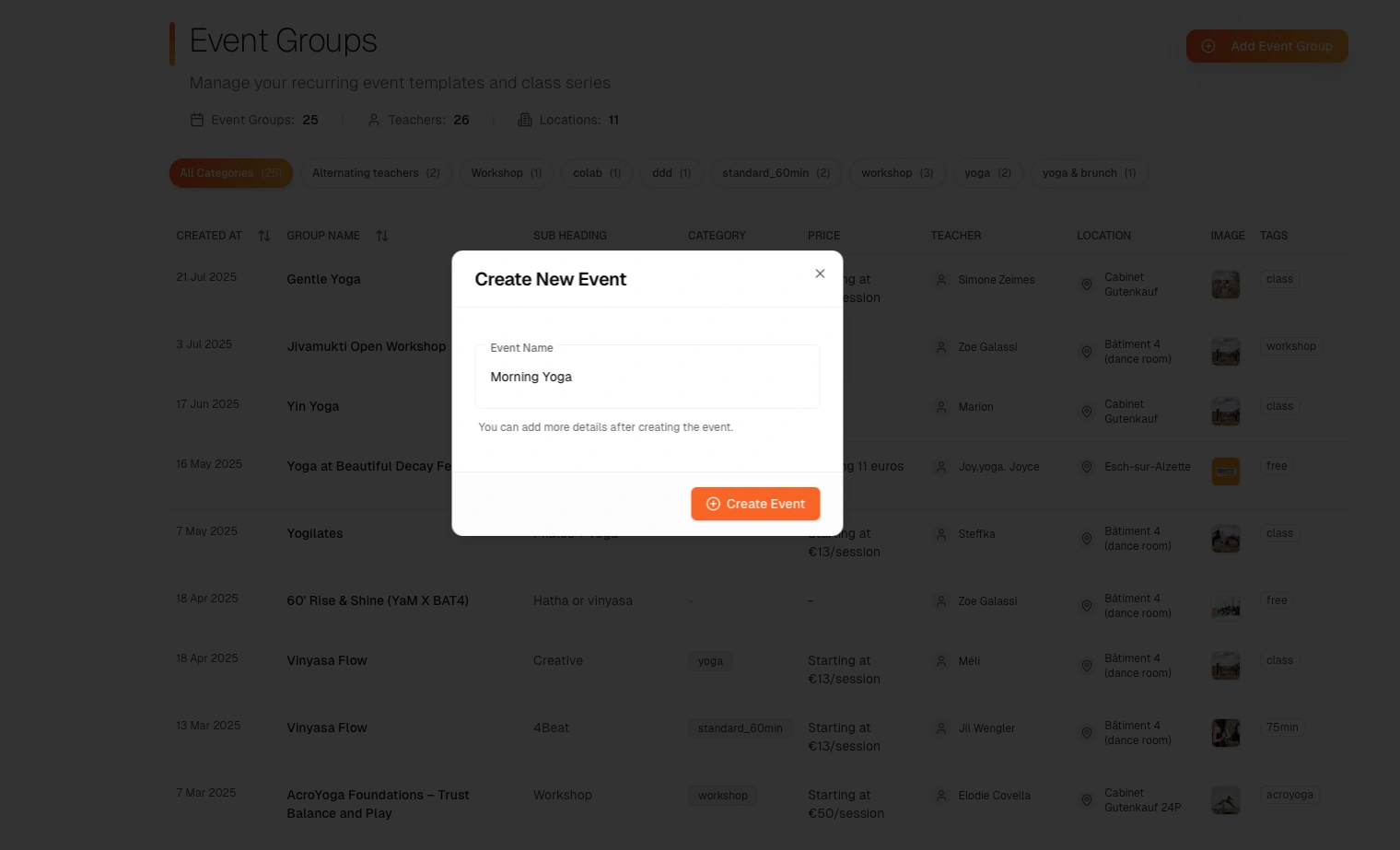An event in Naayya is any activity that happens at a specific location and time—the umbrella term for everything your studio offers. Events include regular classes, special workshops, one-time sessions, and ongoing series. Each event has its own schedule, pricing, and booking options customers can book and attend.

Creating Your First Event#
Navigate to the events page and click the "Add Event Group" button in the top right corner. Enter a name for your event and click "Create Event". You'll be redirected to the event settings page where you can configure all the details.
Event Configuration#
Event Image#
Upload one image per event by clicking the image upload area. Your image will be displayed in two different formats to look great on all devices:
Desktop View (Cinematic 2.35:1)
- Widescreen format perfect for landscape shots
- Recommended size: 1920×817 pixels
- Best for scenic backgrounds and wide compositions
Mobile View (Standard 4:3)
- Traditional format ideal for portraits and vertical content
- Recommended size: 1200×900 pixels
- Best for close-up shots and people-focused images
Technical Requirements
- Maximum file size: 5MB
- Supported formats: JPG, PNG, WEBP
- The cropping tool will help you optimize for both desktop and mobile views
Basic Information#
Event Name: Click the pencil icon next to the title to modify the event name at any time.
Sub-heading: Add an optional tagline that appears under your event title. Examples include "Beginner Friendly" or "All Levels Welcome".
Description: Write 2-3 sentences describing what customers can expect. Focus on what they'll learn or experience during the event.
Category: Assign your event to a category for better organization. Type any category name - new categories are created automatically if they don't exist. Categories help group similar events together for easy filtering.
Teacher and Location#
Teacher Assignment: Select the instructor for this event from the dropdown menu. If no teachers appear, you'll need to add them first at Admin > Teachers.
Location Setup: Choose where the event takes place from the location dropdown. If the dropdown is empty, add locations first at Admin > Locations.
Pricing Display#
The Price Display Text field shows what customers see on the booking page. Enter display text like "$25", "Free", "Contact us", or "$20-30". This is purely for display - actual pricing is configured separately in the Event Products section.
Event Tags#
Tags are internal labels used to automate teacher payouts, reporting, and other system calculations. Customers never see these tags.
How Tags Work
- Events with identical tags receive the same teacher pay rates
- When calculating payouts, the system uses the first tag if multiple exist
- Tags group events together for financial reporting and analytics
Common Tag Examples
premium-class- Higher payout rate for advanced or specialized sessionsbeginner-class- Standard rate for introductory classesworkshop- Special payout structure for one-time workshopsprivate-session- Custom rates for 1-on-1 instruction
Setting Up Tags Type a tag name and press Enter to add it. Use existing tags from the dropdown suggestions to ensure consistent payout calculations across similar events. The first tag determines the pay rate when multiple tags are assigned.
Publishing Events#
Setting Up the Schedule#
Before customers can book, you need to create event instances. Go to the "Schedule" section and click "Add Event Series". Set your dates, times, and choose a recurring pattern if applicable.
Configuring Pricing#
Set up actual pricing in the "Event Products" section. Add at least one product, set the price, and configure payment options.
Going Live#
Once you've configured the basic details, schedule, and pricing, click the "Go Live" button to make your event visible to customers. Events remain hidden until you manually publish them.
Troubleshooting#
Changes won't save: Ensure all required fields are completed (name, teacher, location).
Event not visible: Verify you've selected the correct studio from the dropdown.
No booking button: Confirm you've added event instances in Schedule and set up products in Event Products, then clicked "Go Live".
Blurry images: Upload a larger image (1200x800px recommended) under 5MB.
Best Practices#
Start with the essentials: event name, teacher, and location. You can always add more details later. Test the booking process by creating a test booking to ensure everything works correctly. Consider duplicating successful events to save time when creating similar offerings.